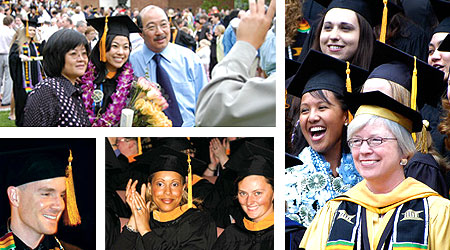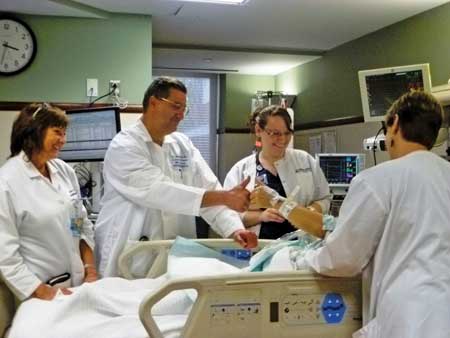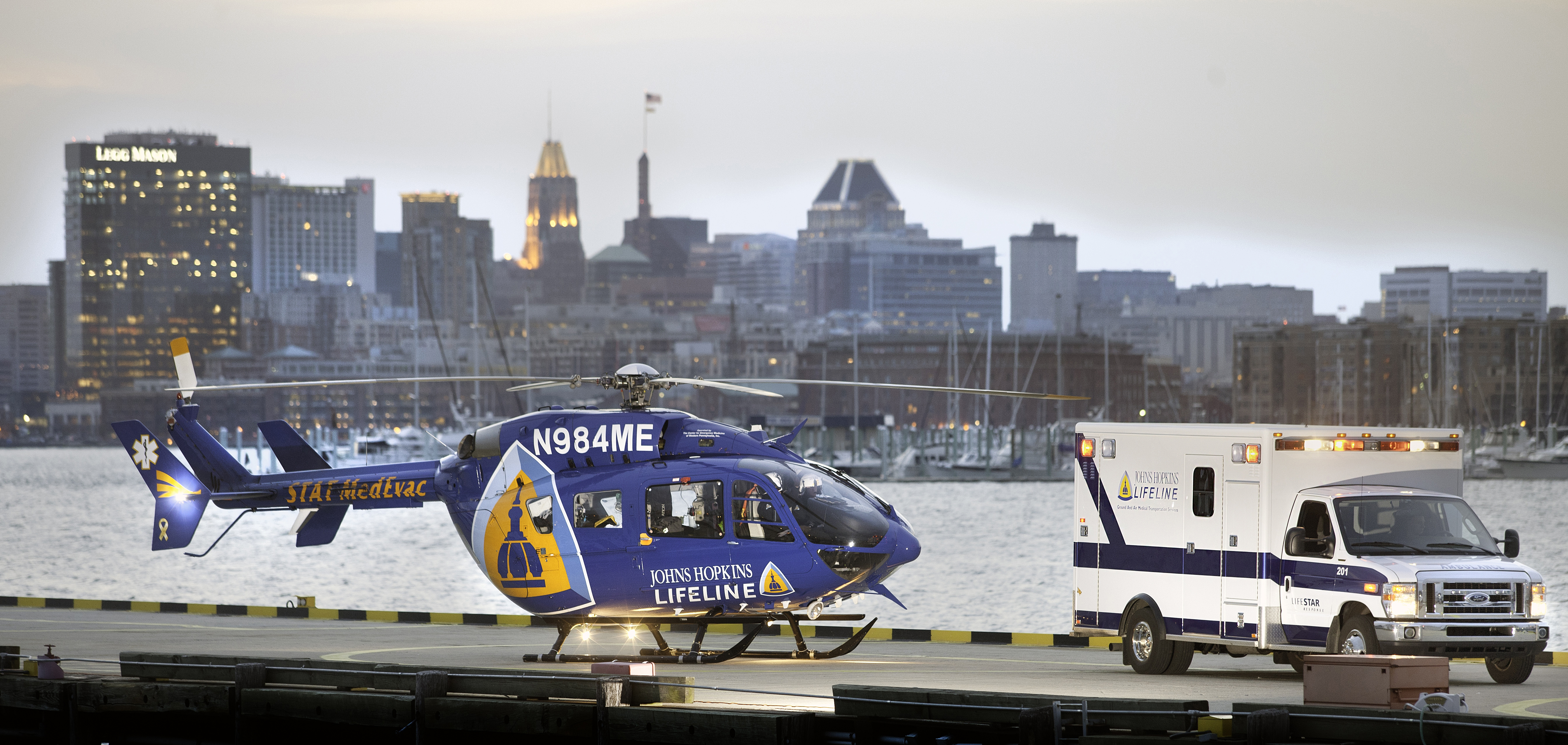By Elizabeth Heubeck
Illustrations by Linda Fountain
Through collaborative programs with other renowned divisions within Johns Hopkins University, the School of Nursing has vastly expanded opportunities for nurses to lead.

Jamie Mignano, MSN/MPH ’06, is packing to go to Uganda. Every few months, she travels to developing countries that have been hit hard by HIV/AIDS. She is no longer shocked at how the disease ravages entire populations. Nor does she have any grand notions of personally fixing the lives broken by it. “I’m not going to save anybody. Public health nursing is really about being able to assess a situation, and to use that assessment to work with the community and find out what’s going to work for them,” says Mignano, a program specialist with Baltimore-based Catholic Relief Services (CRS).
In her position with CRS, Mignano supports the organization’s programs by teaching health care workers to treat and care for people with HIV/AIDS in the countries that have been most devastated by it, and which typically have the fewest resources to combat it.
Mignano’s unique combination of nursing and public health skills makes her highly effective in the position. After obtaining a bachelor’s degree in economics with a concentration in international relations, she completed her BSN at the Johns Hopkins University School of Nursing. Eager to bring an international angle to her graduate nursing studies, she opted for the dual MSN/MPH at Johns Hopkins.
| “Public health nursing is really about being able to assess a situation, and to use that assessment to work with the community and find out what’s going to work for them.” |
| —Jamie Mignano |
“There really aren’t any other programs like the one at Hopkins,” she says. “There are a lot of master’s programs in public health that aren’t focused on nursing. It’s hard to find the combination. Plus, the opportunities to train for a career in international health are really strong at Hopkins.”
The dual MSN/MPH was launched at Johns Hopkins in 1993, a time when other institutions were also developing dual programs. “We thought, ‘We have a great school of public health right next door, and a great nursing program.’ It made sense to combine them,” says associate professor of nursing Joan Kub, PhD, APRN, BC, program director. Since then, the program’s student body has grown to more than 12 times its original size. Consistently rising enrollment can be attributed to several factors, including the excellent reputations of both the School of Nursing and the Bloomberg School of Public Health. Flexibility is also key: Students can choose to pursue an 18-month full-time option, or to attend part time up to five years. The opportunity to concentrate in one of several areas—including maternal health, disaster preparedness, international health, and community health—draws students with a range of professional interests. The MSN-NP/MPH program, a new but related dual option that combines the MSN-Nurse Practitioner and the MPH, lures yet another subset of students. “You’re getting the nurse practitioner skills, but with a public health slant,” explains Kub.
Regardless of which track students choose to pursue, they can count on significant practical experience to support their classroom learning. Each dual master’s candidate must complete three practicums prior to graduation. “It allows them to actually synthesize the information they’re learning and put it to practice,” Kub says.

The first practicum experience involves a population-based intervention. One student, for example, who is concentrating on public health within the geriatric population worked at Apostolic Towers, a housing complex for low-income senior citizens in East Baltimore, to improve the residents’ level of physical activity.
The second practicum enhances grant-writing skills. “After assessing a community or program around a specific health issue, students write a small, service-related grant,” Kub explains.
The third practicum, which requires students to evaluate an existing public health program, is considered the pinnacle of the students’ learning experience. “Last semester, a student worked in Senator [Barbara] Mikulski’s office on legislation policy,” Kub says.
Through a practicum with the American Red Cross (ARC), Mignano performed a community assessment of the role volunteer health care personnel play during emergency situations. “The chance to do a community assessment, a major skill in public health nursing, was invaluable,” she says. Putting her astute assessment and nursing skills to the test, Mignano also was tasked with writing the infectious disease portion of the ARC’s updated manual on emergency disasters.
Performing community assessments in graduate school has served Mignano well in her current project with Catholic Relief Services. “We’ve done quality assurance in every developing country we work in,” she says. “It’s bringing hope where there was no hope before.”
The MSN/MBA: Advanced Business Skills for Real-World Management
After six years of working as a floor nurse at Cleveland Clinic’s high-paced cardiovascular surgical unit, Christine Moniz, MSN/MBA ’02, could care for the very sickest of patients with utmost confidence. But when she returned to school to pursue a dual MSN/MBA at Hopkins, she suddenly felt inept. “I had never been in a business class in my life. Initially, it was terrifying,” she recalls.
The feeling didn’t last long. “It turned out to be the best learning experience ever,” Moniz says. She recalls her Marketing Management class, part of the MBA curriculum, in which students learned to analyze a company’s overall performance and direction. “Coming from the hospital floor environment, this idea was completely foreign to me. Being in class with students who did this for a living was helpful,” Moniz says.
Program administrators agree. “The students really benefit by taking the business courses with others who have different backgrounds. Bankers and real estate agents are right alongside nurses,” says Kathleen White, PhD, RN, CNAA, BC, director of the MSN program. “It just makes sense.”
Practicality pervades the 57-credit program, established in 1997. For starters, pursuing these two degrees concurrently lessens the overall curriculum burden. That’s because some of the programs’ requirements, like Ethics and Informatics, overlap. “Students get economy of scale while pursuing both degrees,” since they only have to take each course once, White explains. The option to complete the program on either a full- or part-time basis demonstrates another practical aspect of the dual program. So, too, does immersing students in an environment that emulates the dynamics of the business world.
| “Nurses who get into management and administrative roles need to have some advanced business skills so they can be functioning members at the finance table” |
| —Kathleen White |
The MSN/MBA is far cry from the way nurses used to arrive at management. Years ago, floor nurses occasionally rose through the ranks to become administrators, despite having had little business experience beyond managing a staff of floor nurses. “Because they were the best nurse on the floor, they were made management. But often, they were flying by the seat of their pants,” White says.
These days, that’s not enough. “Nurses who get into management and administrative roles need to have some advanced business skills so they can be functioning members at the finance table,” White says. Program courses like Financial Accounting, Financial Management, Corporate Finance, Management and Organizational Behavior prepare MSN/MBA students for managerial positions in today’s complex business world.
The courses are structured as deliberately as their content is developed. “Public speaking, group work, leading class discussions—these were skills that I had never had to practice as an undergraduate,” Moniz says. The dual MSN/MBA program heavily emphasizes these competencies, with countless opportunities in the classroom to practice them. There’s a reason for the emphasis.
In the business world, few decisions are made alone. Hence, the program gives students as much experience as possible leading and working within groups. It culminates with a final project prior to graduation. “The ‘capstone’ course is called Competitive Strategy, whereby the students work in groups and produce a complete business plan for a real-world problem,” White says.
While Moniz admits to having been initially uncomfortable in front of a group, honing her leadership and public speaking skills has paid off. When she graduated from the MSN/MBA program, she accepted a position as a clinical consultant with Thoratec Corporation, which manufactures medical devices. The position required Moniz to teach four-hour courses to health care professionals on the complex, state-of-the-art devices, to maintain an authoritative presence during all surgeries in which the devices were being implanted, and to follow the patient in the hospital after the procedure. ”
If I had accepted this job just coming off the [cardiovascular] unit, I wouldn’t have been able to handle these pressure situations,” she says.
The MSN with a Certificate in Nurse-Midwifery: Providing Women’s Health Care Across the Lifespan
Academic programs that certify students to become nurse-midwives are few and far between, despite their potential to help fill a broad role in women’s health care.
“Nurse-midwives could really be the care providers for women across their lifespan,” says Hopkins assistant professor of nursing Elizabeth (Betty) Jordan, DNSc, RNC.
A new collaboration between the Johns Hopkins University School of Nursing (SON) and Shenandoah University, set to begin this fall, will prepare more nurse-midwives to take on this viable role in the future.
The partnership will allow Hopkins MSN students enrolled in the clinical nurse specialist track to receive a Certificate in Midwifery from Shenandoah University Division of Nursing. MSN students will take core courses at Hopkins. Classes focusing on midwifery will be taken at Shenandoah University, located in Winchester, Virginia. Students will have two distinctly different settings—one urban and one rural—in which to perform their required clinical work.
“It will allow advanced nurse practitioners to really lead the way in providing continuous care, from the first time a young girl goes into a GYN exam and needs information on the HPV vaccine to delivering well women’s care to an 80-year-old woman,” Jordan says.
The Baltimore architectural firm, Ziger/Snead LLP, was selected to do the master planning and design work because it is highly regarded as progressive. Among other projects, the firm has designed the addition to the Johns Hopkins University Bloomberg School of Public Health and the stunning Downtown Center of Hopkins’ Carey Business School on Charles and Fayette streets.
Pinkard says he is encouraged by the East Baltimore master plan because it is long-range and forward thinking. “Health care is changing dramatically,” Pinkard says. “The way care is delivered in the clinical setting relies very much on collaboration and teamwork.” That teamwork, he says, has to be fostered among the university’s health divisions.
As Ziger and Brady outline the master plan, they talk first about Phase One, to be started in 2008. It will include the four-story atrium to the east of the current Pinkard Building, which will connect to an eight-story building housing the nursing school and the Berman Bioethics Institute. The Berman Center will have an entrance on Jefferson Street, and occupy the top three floors of the building, while the School of Nursing will occupy the basement and the first five floors. The architects also hope to include elements that contribute to a sustainable environment such as the “green roof” concept that helps create cleaner air and healthier communities.
 Living Your Life through Nursing
Living Your Life through Nursing We're No. 4!
We're No. 4! Compassionate Care for Open Heart Patients
Compassionate Care for Open Heart Patients Dispatched to Cure Transportation Ills
Dispatched to Cure Transportation Ills







